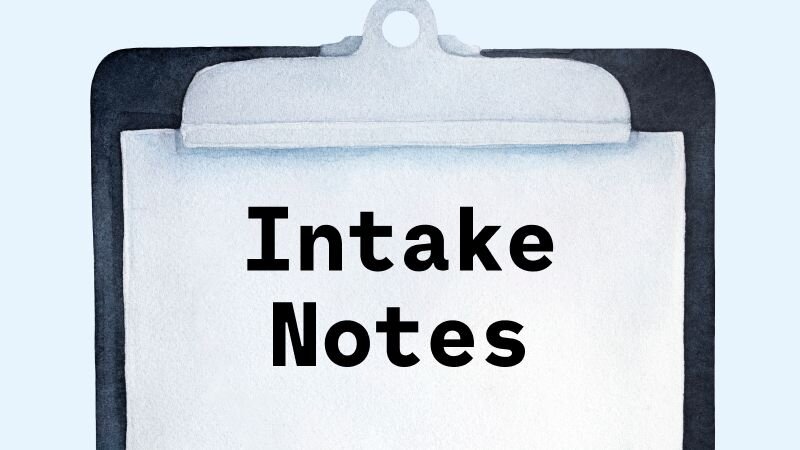
How to write a therapy intake note
The intake assessment is your chance to get a deep understanding of your patient — and maybe connect some elements from their journey that they wouldn’t connect themselves.

Be strategic and ensure you and your potential client have the information you need to start therapy on the right foot.
An intake session marks the beginning of treatment with a new client. This first appointment is an important part of determining whether you’re the right fit for someone, and if so, diagnosing them and beginning to craft a treatment plan.
“The intake session helps you build rapport with someone and making sure you can connect in future sessions,” says Abby Gagerman, a Chicago-based Licensed Clinical Social Worker and founder of AEG Wellness.
It’s also the first opportunity to start building a trusting relationship with your client, which is one of the most important factors in making sure therapy is successful. Studies have consistently found that a strong therapeutic alliance correlates with better treatment outcomes across various types of psychotherapies.
You can use your intake sessions to be strategic and ensure you and your potential client have the information you need to start therapy on the right foot. Below, learn more about how to conduct an efficient and effective intake session, according to a therapist in private practice.
After a potential client reaches out to you about therapy, you can start the process. Take a close look at your caseload and schedule so you know when (and how often) you can reasonably schedule appointments with the new client. Be prepared with a list of referrals, too, so you can recommend another clinician in case either of you decide it’s not best to move forward together. It may help to have your client fill out forms ahead of the appointment to save time, too.
Next, think about how you want to structure the actual intake session. Gagerman says she has a go-to outline for intakes, which helps her make the most of time and make sure she covers everything she wants to address. Along with outlining the session, she comes up with a list of interview questions to get the client talking, which she says helps her land on a diagnosis and treatment plan (both of which are important for insurance billing).
The therapeutic relationship begins as soon as your client arrives at the intake appointment. Before you dive into the client’s story, take time to go over the logistical components of therapy. If needed, explain the intake forms they filled out, what they mean, and how they affect the therapy process.
Then, introduce your approach to therapy and what a client can expect from working with you to help them mentally solidify whether you’re the right clinician for them. Make space for the client to ask you any lingering questions about you or what it’s like to work with you as a therapist. Then, spend some time getting to know your client and their needs.
“The goal is to get them talking about who they are, what they’re looking for, and what’s worked or not worked for them in the past,” says Gagerman. “This helps you know where to start in therapy.”
You can also invite the client to share their availability and to schedule their next appointment if they’re ready. Gagerman typically explains at this point that it usually takes three sessions for her to come up with a comprehensive treatment plan.
“I tell the client to give me three sessions, and if they think it’s not a good fit, I’ll refer them without being offended,” she says.
Being prepared with interview questions can help you get the most out of your session by better understanding your client’s history, symptoms, goals, and needs. Along with providing a framework for determining whether you’re the right therapist for someone, these questions can help shape your diagnosis and treatment plan.
If you’re seeing a client through their insurance plan, payers often have expectations for what is addressed with a client in the intake session. Make sure you’re familiar with the requirements of an intake note as you plan your intake assessment.
Possible intake interview questions to consider include:
Some questions may have been covered in your intake paperwork. You can ask for more details as needed in the intake session, or focus on something else all together — whatever helps you meet insurance expectations while getting the clearest picture of who your client is and whether or how you can support them.

The intake assessment is your chance to get a deep understanding of your patient — and maybe connect some elements from their journey that they wouldn’t connect themselves.
A successful intake session doesn’t necessarily end when the client leaves your office. You likely won’t need to reach back out to the client, unless you didn’t schedule upcoming appointments during the intake or you have any issues with their insurance coverage.
Instead, you’ll need to take time to process the session and write your formal intake note. Use the documentation process as an opportunity to think through your client’s needs and how you can best help support their mental health goals. All of this will help guide future sessions, says Gagerman.
If you’re working with insurance, you’ll need to land on a diagnosis in order to bill. This may involve comparing the client’s history and symptoms against established diagnostic criteria, or talking to previous mental health clinicians or medical providers about the client. Your intake notes should document the symptoms that demonstrate the client meets the criteria for the diagnosis.
Then, based on your diagnosis and the client’s individual preferences and needs, you can come up with a treatment plan that makes sense.
“It can take some time to do this, but that’s why insurance usually pays therapists more for intake sessions,” says Gagerman. “You’re not just doing a longer session with an intake, you’re putting in more work after the session so you can figure out how to best support your client.”

As a therapist, your superpower is helping other people. So it may feel a little weird to turn the tables and talk about yourself and your accomplishments as you’re building your website, creating social media profiles, and signing up for therapist directories.

Getting a great therapist photo requires a bit of strategy — but don’t stress. You won’t need any fancy tools, and you don’t even have to hire a pro if it’s not in the budget.

Psychology Today is one of the most prominent players in the directory game — and strategically using it as a marketing tool can help you grow your practice.